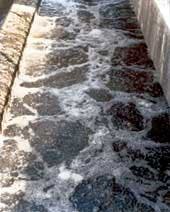The denitrification system employs a "bump" operation to remove or purge accumulated gas - nitrogen or CO2 - that can potentially build up in the filter media.
Over the past 30 years, wastewater treatment plants along the East Coast - from New England to Florida -- and extending out to the West Coast have faced increasingly stringent regulations as total maximum daily loads (TMDLs) for nutrient discharges have been developed and further revised by federal and state agencies to address water quality concerns. During that period, deep bed denitrification filters have proven to be an effective treatment technology used by wastewater plants to meet low total nitrogen (TN) limits.
The combination of denitrification and solids removal in a deep bed filter process was first patented in 1979, and since then the technology has been responsible for helping improve wastewater quality at treatment plants across the country.
Ammonia, Nitrogen, Phosphorus
The nitrogen we consume as protein in our food is not all used in our bodies, and so each day we excrete nitrogen in the form of ammonia. Ammonia is highly toxic to fish and other animals, so ammonia and total nitrogen levels in wastewater treatment and effluent discharges must be closely monitored to ensure the nutrient levels are not harmful to receiving streams. The wastewater quality monitoring process is critical to ensuring that the effluent discharge levels are safe for wildlife. Additionally, the monitoring of total nitrogen levels is used to document discharge levels against set regulatory limits - a critical function since non-compliance can result in penalties to a wastewater facility.
The City of Largo Advanced Wastewater Treatment facility is known for its use of innovative wastewater treatment processes.
Wastewater treatment plants have been designed to convert ammonia via aeration into nitrate-nitrogen (NO3-N). Nitrate-nitrogen promotes plant growth, so excess levels can cause algae blooms and other oxygen-depleting growth in rivers, lakes and other water bodies. In addition, nitrates can be harmful for human consumption if introduced into drinking water supplies.
Phosphate in wastewater also will encourage growth in rivers and lakes. Eutrophication causes algae to amass, impacting the ecological balance of local ecosystems.
When full nitrogen removal is required, one of the available treatment methods is biological denitrification. During this form of denitrification, nitrate-nitrogen is biologically converted into nitrogen gas, thus playing an integral role in maintaining the integrity of the wastewater treatment plant’s receiving waters.
Deep Bed Filtration
Filtering liquids through deep beds of porous granular media to improve their clarity is widespread in municipal and industrial practice. This treatment process is now often used in tertiary wastewater filtration for reuse. Additionally, the removal of nutrients provides advanced wastewater treatment quality effluent.
The Tetra Denite® process from Severn Trent Services is one example of deep bed filtration technology used in the denitrification process.
As both a bioreactor and effluent filter, the Tetra Denite system combines deep bed filtration and fixed-film biological denitrification to achieve a high level of process synergy. Simultaneous removal of total suspended solids (TSS) and nitrate-nitrogen achieves 1 ppm nitrate-nitrogen and 3 ppm total nitrogen or less.
Fundamental to this process is the specially sized and shaped granular media used in the fixed-film biological filters. The high solids loading capacity of the media is ideal for retaining biological solids produced by the denitrification process. The surface area of the 2-3 mm diameter sand particles is very large, providing 1000 m2 per cubic meter contact between the wastewater supply and the biomass.
During this fixed-film biological denitrification process, wastewater is forced to flow around nitrogen gas bubbles that accumulate in media voids in the filtration vessel, improving biomass contact and filtration efficiency. Effective removal of nitrate-nitrogen is undertaken by introducing methanol using the TetraPace automatic dosing control. This dosing control scheme is based on an influent flow signal combined with an influent and effluent concentration analyzer.
The advantages of tighter methanol control can be significant if the plant has a stringent biochemical oxygen demand (BOD) limit in combination with a low total nitrogen limit. Under these conditions, the tighter control and reduced risk can be a critical component in ensuring the plant meets limits reliably. The accuracy of the proprietary algorithm used to feed methanol during the denitrification process enables TetraPace to yield savings of up to 30 percent in methanol consumption costs while guaranteeing effluent quality with a “no net TOC pickup across the filter” guarantee.
Severn Trent Services employs a “bump” operation to remove or purge accumulated gas - nitrogen or CO2 - that can potentially build up in the filter media. If desired, this “bumping” can be accomplished without removing the reactor from service using SpeedBump, which applies backwash water to the bottom of the filter, releasing the entrapped gas into the atmosphere and reducing head loss.
An added benefit to the Denite process is the removal of phosphorus, which is consumed in the cell wall biology of the biomass. The trapped solids are backwashed out of the filter by a simultaneous injection of air and water, and returned to the upstream biological treatment units at the end of each cycle. By operating down flow, excellent levels of solids removal are achieved, eliminating the need for additional effluent polishing filters.
Largo, Florida
The City of Largo Advanced Wastewater Treatment facility has often been mentioned in professional publications and textbooks as a treatment plant that implements innovative wastewater treatment processes. In fact, the TetraPace and SpeedBump technologies were first developed for use at the Largo AWTP.
The plant has nine denitrification filters, each 10 ft. x 60 ft. Six feet of large, rounded sand media provides long run times, depth storage of TSS and attachment room for denitrifying biomass.
Concrete underdrain blocks support the gravel and media, while simultaneously protecting a grid of stainless steel air laterals. This underdrain configuration is ideally suited for use in wastewater treatment facilities, with large passages that resist clogging from biomass and TSS.
Vigorous simultaneous air/water backwash at a relatively low backwash water rate consumes only about 2% of forward flow.
Between 1997 and 2001, Largo’s effluent operating data showed an average flow of 12.5 mgd; BOD of 2.17 mg/L; total-N of 1.71 mg/L; and TSS of 0.65 mg/L.
Scituate, Massachusetts
The Scituate Advanced Wastewater Treatment facility uses four 9.5 ft. wide x 32 ft. long deep bed filters and employs the TetraPace automatic dose control system. This system uses plant flow, influent and effluent nitrate-nitrogen to pace methanol dosage.
This plant is notable for the excellent cold weather performance of its denitrification filters. Daily data collected over the period from November 11, 2003, through January 31, 2004, showed very consistent denitrification to below 0.5 mg/L nitrate-nitrogen. The last month of data was at a wastewater temperature of about 8o C.
Averaging all data revealed the following results during this period: Average Flow of 1.31 mgd; water temperature of 11.7oC; influent nitrate-nitrogen of 10.2 mg/L; effluent nitrate-nitrogen of 0.50 mg/L.
Tampa, Florida
The Howard F. Curren Advanced Wastewater Treatment Plant in Tampa is the largest denitrification filter plant in the world. It was constructed in 1978 with twenty 10 ft. wide x 105 ft. long filters. Twelve filters of similar size were added in 1992.
The majority of the plant’s denitrification process is performed on the filters themselves with an efficient methanol/nitrate-nitrogen ratio of 2.95 to 1. Presently, up to 20-25 mg/L of nitrate-nitrogen are reduced to approximately 1 mg/L before discharge. Solids removal across the filters is equally impressive.
The improvement in filtered effluent quality of the large flow from this plant has been a documented factor in the revitalization of Tampa Bay over the last few decades. Sea grasses, turtle grasses and sport fish have returned to once barren areas of this Outstanding Florida Waterway (OFW).
Five years of effluent data (1997-2001) reveal the following results: Average flow of 53.4 mgd; BOD of 2.52 mg/L; Total-N of 2.5 mg/L; TSS of 0.96 mg/L.
About the Author:
David C. Slack is General Manager of Severn Trent Services. He has over 39 years of experience in sales and engineering services to the utilities, steel, municipal, chemical and wastewater treatment industries, including the development of new processes in the metallurgical, electrical, food and wastewater markets. Slack has a BS in Electrical Engineering and an MBA in Economics.





